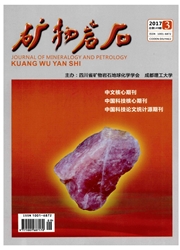

 中文摘要:
中文摘要:
通过对德钦县贡卡-书松地区蛇绿岩的岩石学特征、地球化学特征及形成时代进行分析,结果表明该区蛇绿岩套岩石组份有超镁铁质岩、基性岩墙、中基性熔岩、紫红色硅质岩及灰岩。其中超基性岩为镁质、贫铝系列,微量元素表现为仅少量大离子亲石元素富集型;放射性生热元素U为富集型。基性岩岩石的微量元素表现为大离子亲石元素富集型;放射性生热元素Th富集,稀土元素丰度反映LREE富集,显富轻稀土型,表明该蛇绿岩套属扩张洋脊型。书松地区粗玄岩内锆石年龄为300.06Ma,洛玉村一带辉绿岩及辉长岩中锆石年龄为(252.4±1.7)Ma和(258.7±2.7)Ma,表明研究区内蛇绿岩套形成时代大约在晚石炭世-晚二叠世,与峨眉地裂运动相对应,是拉张活动的中心区域。
 英文摘要:
英文摘要:
Study of petrology,geochemistry and geochronology of ophiolite in the Gongka-Shu- song area shows that the ophiolite is composed of peridotite, basic rock wall, intermediate lava, purple colored siliceous rocks and limestone. The ultrabasic rocks belong to magnegium and poor aluminum series with a small number of large LILE enrichment and the basic rock showed large LILE enrichment. REE abundances show LREE enrichment, indicating that the ophiolites were spreading ridge type. Zircon dating age from dolerite of Shusong area was 300.06 Ma and from diabase and gabbro of Luoyucun area was (252. 4±1.7) Ma and (258.7±2. 7) Ma respectively. Therefore,the ophiolites were formed around the Late Carboniferous-Late Permian period, corresponding to Emei taphrogeny.
 同期刊论文项目
同期刊论文项目
 同项目期刊论文
同项目期刊论文
 期刊信息
期刊信息
